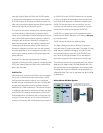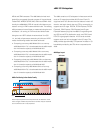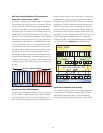9
ups and operations. Any unused PUs can be utilized as
spares. The inactive PUs on the MCM are available to be
characterized as either Central Processors (CPs), Internal
Coupling Facility (ICF) processors for Coupling Facility
applications, Integrated Facility Linux (IFL) for Linux appli-
cations, or as IBM ^ zSeries Application Assist
Processor (zAAP) engines, providing enterprises with tre-
mendous fl exibility in confi guring the best system for run-
ning applications. Each model of the z890 must always be
ordered with at least one CP, IFL or ICF.
The PU, which uses the latest chip technology from IBM
semiconductor laboratories, is built on CMOS 9S-SOI with
copper interconnections. The 14.1 mm x 18.9 mm chip
has a cycle time of 1.0 nanoseconds and is identical to the
z990 PU except for the cycle time. Implemented on this
chip are leading edge functions as the z/Architecture with
its 64-bit capabilities including instructions, 64-bit General
Purpose Registers, SuperScalar function, translation facili-
ties, ability to use long displacement operations and on
board Cryptographic Assist functions.
The z890 is a single book design. The book can support
up to 32 GB of memory on a single memory card and 8
Self-Timed Interconnects (STIs) for I/O Connectivity. The
memory which can be purchased in 8 GB increments, is
delivered on 8 GB, 16 GB or 32 GB cards. The minimum
memory is 8 GB. The book has a 2 Memory Bus Adapters
(MBAs) and each MBA supports 4 STIs.
The z890 supports LPAR mode only (basic mode is no
longer supported).
The MultiChip Module (MCM) is the technology corner-
stone for fl exible PU deployment in the z890 models. For
most models, the ability of the MCM to have inactive PUs
allows such features as Capacity Upgrade on Demand
(CUoD), Customer Initiated Upgrades (CIU), and the ability
to add CPs, ICFs, IFLs and zAAPs dynamically provid-
ing nondisruptive upgrade of processing capability. Also,
the ability to add CPs lets a z890 with spare PU capacity
become a backup for other systems in the enterprise;
expanding the z890 system to meet an emergency outage
situation. This is called Capacity BackUp (CBU).
The I/O SubSystem has been enhanced to support two
Logical Channel SubSystems (LCSSs) which provide the
capability to defi ne up to 512 CHPIDs (256 CHPIDs per
operating system image). I/O improvements in the Parallel
Sysplex Coupling Link architecture and technology sup-
port faster and more effi cient transmission between the
Coupling Facility and production systems. HiperSockets
™
provides high-speed capability to communicate among
virtual servers and Logical Partitions; this is based on
high-speed TCP/IP memory speed transfers and provides
value in allowing applications running in one partition to
communicate with applications running in another without
dependency on an external network. Industry standard
and openness are design objectives for I/O in z890. The
improved I/O subsystem is delivering new horizons in I/O
capability and has eliminated the 256 limit to I/O attach-
ments for a mainframe.


















